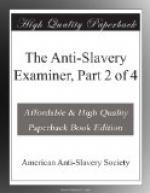The Executive Committee of the American Anti-Slavery Society, deemed it important that the silence which the pro-slavery press of the United States has seemed so desirous to maintain in regard to what is strangely enough termed the “great experiment of freedom,” should be thoroughly broken up by a publication of facts and testimony collected on the spot. To this end, REV. JAMES A. THOME, and JOSEPH H. KIMBALL, ESQ., were deputed to the West Indies to make the proper investigations. Of their qualifications for the task, the subsequent pages will furnish the best evidence: it is proper, however, to remark, that Mr. Thome is thoroughly acquainted with our own system of slavery, being a native and still a resident of Kentucky, and the son of a slaveholder, (happily no longer so,) and that Mr. Kimball is well known as the able editor of the Herald of Freedom, published at Concord, New Hampshire.
They sailed from New York, the last of November, 1836, and returned early in June, 1837. They improved a short stay at the Danish island of St. Thomas, to give a description of slavery as it exists there, which, as it appeared for the most part in the anti-slavery papers, and as it is not directly connected with the great question at issue, has not been inserted in the present volume. Hastily touching at some of the other British islands, they made Antigua, Barbadoes, and Jamaica, successively the objects of their deliberate and laborious study—as fairly presenting the three grand phases of the “experiment”—Antigua, exemplifying immediate unrestricted abolition; Barbadoes, the best working of the apprenticeship, and Jamaica the worst. Nine weeks were spent in Antigua, and the remainder of their time was divided between the other two islands.
The reception of the delegates was in the highest degree favorable to the promotion of their object, and their work will show how well they have used the extraordinary facilities afforded them. The committee have, in some instances, restored testimonials which their modesty led them to suppress, showing in what estimation they themselves, as well as the object of their mission, were held by some of the most distinguished persons in the islands which they visited.




